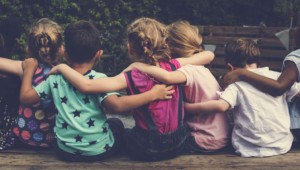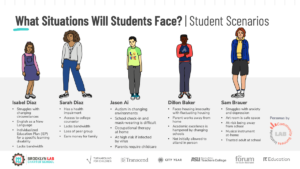There Are No Silver Bullets: 3 Levers For SEL Success

By Jillian Darwish
Myths are common in education. The most persistent is the silver-bullet myth. You know, the one that goes something like, “If we just do _____, we will fix education.”
No matter what fills in the blank, this statement won’t be true because one symptomatic “tweak” simply can’t produce a complete “fix” in any complex system.
There is good news. For those educators willing to think systemically, profound change is possible by utilizing the science of character strengths and social emotional learning to remake school culture. Our nearly 24 years as a professional learning services firm, working with thousands of educators around the world, tells us that intentionally shaping a positive learning culture with research-based strategies energizes and maximizes every effort towards shared goals and encourages learners of all ages to be their best every day. It is the silver tool, not the silver bullet, that builds systemic and transformational change.
Strong, Not Wrong
Helping learners thrive. It is the reason educators choose to work in schools. They instinctively know that reaching this aim is about more than acquiring narrowly defined subject knowledge. They see learners as the whole individuals that they are and aim to cultivate social and emotional (SEL) competencies, knowing these capacities are critical for flourishing in school and beyond.
Even with this insight, developing self-awareness, self-management, social awareness, relationship-building and responsible decision-making can be turned into, yet one more, deficit-based program approach, whereby the learner is assessed for what she doesn’t possess. This lens distorts vision to see what’s wrong, not what’s strong in the individual. However, by understanding every learner’s strengths, it is possible to create a personalized and appreciative pathway to develop critical competencies and shape a positive learning culture for all learners.
Breakthrough research confirms the importance of a positive approach. The work of Dr. Barbara Frederickson’s indicates that people “who have more positive emotions in relation to negative emotions are more likely to flourish. They possess the capacity to ‘broaden and build’ ideas, providing the basis for creativity, problem-solving and resiliency.”
3 Musts for Positive Culture Transformation
We have worked with more than 50 schools around the country implementing Thriving Learning Communities™ (TLC), a research-based approach to improving students’ social and emotional competencies by revealing and catalyzing individual character strengths. This work has revealed several critical success factors in creating positive learning cultures.
1. Get Real
Educators who know their own strengths, focus on their own social and emotional development and share their personal experience with students are much more effective in reshaping their classroom and school culture.
A TLC teacher noted that her own personal learning experience was critical to fully bringing character strengths to the classroom. “If we didn’t experience the model for ourselves as teachers, we couldn’t have talked about it as deeply with our children.” Read more in our Teaming for Impact case study.
According to one principal, “Adults need this as much as kids do. If we can acknowledge our top strengths, we can mobilize to achieve great things.” Read more in our Leading with Character case study.
2. Get Involved
In addition to sharing their own stories, educators who are successfully transforming their cultures are also highly skilled at active listening to draw out the experiences of learners.
A TLC principal describes a situation where a young boy had an emotional outburst in class and cried. “He was deeply embarrassed about going back into the classroom,” the principal recalls. The leader asked the boy what he needed to find in himself to return to the classroom and they discussed bravery. “The definition of bravery helped him realize it wouldn’t be easy but that it could be done. My feeling is he could find it in himself because of the work we’re doing.” Read more in our Shared Language Inspires Learning case study.
A Reading Specialist in a TLC school shared how she addressed a problem where there was conflict. “We acted it out and talked about how to handle the conflict. I’ve seen huge growth in the children, and having that character strength language is the key.” Read more in our Amplifying Student Strengths case study.
3. Get Integrated
Dedicated time to introduce character strengths and SEL competencies is critical, but it’s not enough. Culture is transformed through a two-pronged approach—when there is focused attention on introducing new ideas along with embedding implementation throughout the day.
During a recent activity in a school gym, fifth-grade students learning about travel and tourism careers set up a travel fair for younger students. Before they staffed their individual booths representing Brazil, Saudi Arabia and other travel destinations, they gathered and sat on the floor. Hands shot up across the room to volunteer answers about what character strengths would be required to work in travel. Responses included “teamwork,” “creativity” and “zest.” Read more in our Leading with Character and Learning for a Change case studies.
The Resource Coordinator in another school shares excitement for how this work has become integrated in the broader community, not just at the school. “There’s an awakening in the school,” she professes. “The parents feel different. It’s trickling down and manifesting. It’s pervasive.” Key positives in this school’s “awakening” are a decline in discipline issues and an overall increase in family involvement. The principal says the types of discipline issues are less severe, and they’ve made fewer referrals. “We’re having more conversations about the antecedent of behavior. Students are able to articulate and use the language of Thriving Learning Communities to talk about those things.” Read more in our Common Language, Uncommon Community case study.
When teachers and school communities utilize these three practices, they report that the Thriving Learning Communities approach has helped them to:
- foster a positive environment in and out of the classroom;
- provide a common language for educating the whole child;
- help students capitalize on the good in each of them;
- create a stronger, kinder class environment with less bullying; and
- build community and get students speaking to each other about their common ground of strengths.
Across the more than 50 TLC schools, we see engagement, motivation, learning and performance collectively on the rise as educators transform their school cultures.
It’s time we trade in the silver bullets for silver tools!
This blog was originally published on Mayerson Academy
For more, see:
- On Becoming More Than Preparing: 10 Tips on Developing Humans
- How 2 Minutes of SEL Can Change the Tone for the Day
- Getting Smart Podcast | CASEL: Leading Advocate for Social Emotional Learning
Jillian Darwish is President of Mayerson Academy. Follow her on Twitter: @JillianDarwish
Stay in-the-know with all things EdTech and innovations in learning by signing up to receive the weekly Smart Update. This post includes mentions of a Getting Smart partner. For a full list of partners, affiliate organizations and all other disclosures please see our Partner page.







0 Comments
Leave a Comment
Your email address will not be published. All fields are required.